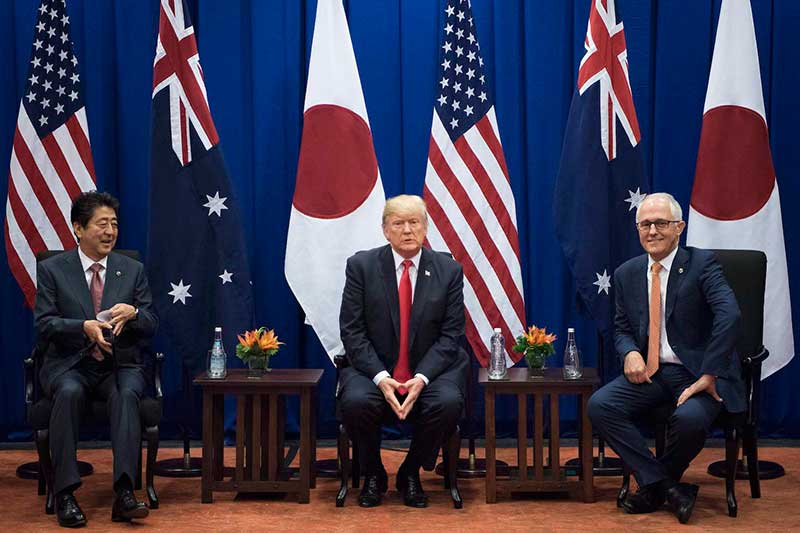Prior to the Association of Southeast Asian Nations (ASEAN) summit in Manila last year, Australia, Japan, India and the United States resurrected a loose security association called “Quadrilateral Security Dialogue” or the Quad.
These four naval powers formed the original QUAD in the sidelines of another ASEAN event, the ASEAN Regional Forum (ARF) Summit in Manila in 2007. The four, however, were not able to come out with a formal agenda or make any decision on reconvening, simply expecting that they would meet again in the near future.
The Quad’s objective was to facilitate consultations and cooperation among the four states in the face of the emergence of China and, later, India as regional powers.
Even so, it was not an anti-China coalition as all four members have extensive economic ties with the country. They were all committed to a policy of constructive engagement, not containment, of this emergent East Asian power.
The Quad could be, therefore, seen as a coalition of maritime democracies seeking to strengthen each other on the basis of shared values and interests. However, its formation indirectly isolated China as a non-democratic power and eroded its diplomatic standing in international gatherings.
Furthermore, the Quad emphasized multilateralism in contrast to China’s bilateral approach. Hence, it offered a model that was quintessential antithetical to China’s approach to international issues and problems.
China saw this association as an alliance of four democracies that would eventually become an “Asian North Atlantic Treaty Organization (NATO) to contain China.” It officially protested its formation and confronted each member about its hidden agenda.
Foreign ministries of the four Quad member states had to explain that the Quad was not about containment or forming an alliance. The Quad suffered a temporary demise when Australia withdrew from the loose association after the election of the Rudd government in 2008.
Setting the stage for the Quad’s revival
The creation and sudden demise of the Quad showed that the association was nothing more than a concept, unlike a military alliance like NATO.
However, two major developments during its 10-year hiatus conspired for its resurrection in 2018: former US President Barack Obama’s strategic pivot to East Asia in 2011 and China’s One Belt, One Road (OBOR), which sought precisely to counter the pivot by outflanking and blunting the US rebalancing through foreign aid and infrastructure projects.
Through the OBOR, China outflanked the Obama Administration’s rebalancing strategy as it directed its geo-strategic efforts towards the Eurasian region away from the Pacific, thus avoiding a direct confrontation with American maritime capabilities.
This enabled China to reap two geostrategic advantages: a) expanding China’s strategic maneuvering space into the Indian Ocean and to Central Asia and b) minimizing direct confrontation and friction in US-China relations.
These two developments led to the geographic expansion of US-China competition from the Asia-Pacific to Indian Ocean area leading to the revival of the Quad and consequently the formulation of a new geographic term — the Indo-Pacific region, in reference to all countries bordering the Indian and Pacific Oceans, an alternative to the conventional Asia-Pacific.
Resurrection of the Quad and birth of the Indo-Pacific
The Quad was revived again in Manila at the sidelines of the East Asian Summit in late 2017. The four-corner security dialogue was revived with a senior official-level interaction with a hint that could eventually become a ministerial-level consultation in the near future.
Upon the initiative of Australia and the US, the Quad again took shape as a four-cornered dialogue, ostensibly to ensure that the Asia-Pacific and the Indian Ocean remains free and open for multilateral trade and commerce.
It emphasizes the importance of rules-based order, connectivity ventures that are not fueled by predatory financing and that territorial disputes are resolved peacefully and in accordance with international law.
The birth of the term Indo-Pacific region underscores the expansion of the ongoing geo-strategic contest between China and the Quad. The earth’s two largest bodies of water — the Indian and the Pacific Ocean — are now a new arena for the competition for territory, resources, and influence.
The main drivers for the enlargement of this great game are: China’s emergence as an economic and military power that has transformed the region’s strategic landscape in a matter of ten years and the Quad’s member states’ balancing approach in their foreign policies.
If the Quad would not confront China’s efforts to effect a revision of the current territorial and maritime arrangement, the next five years could enhance its geo-strategic position.
The result will be the unravelling of the current liberal international order in the Indo-Pacific region and its replacement by a Chinese-led illiberal/authoritarian regional order.
——
Dr. Renato Cruz de Castro is a trustee and convenor of the National Security and East Asian Affairs Program of independent think tank Stratbase ADR Institute.


